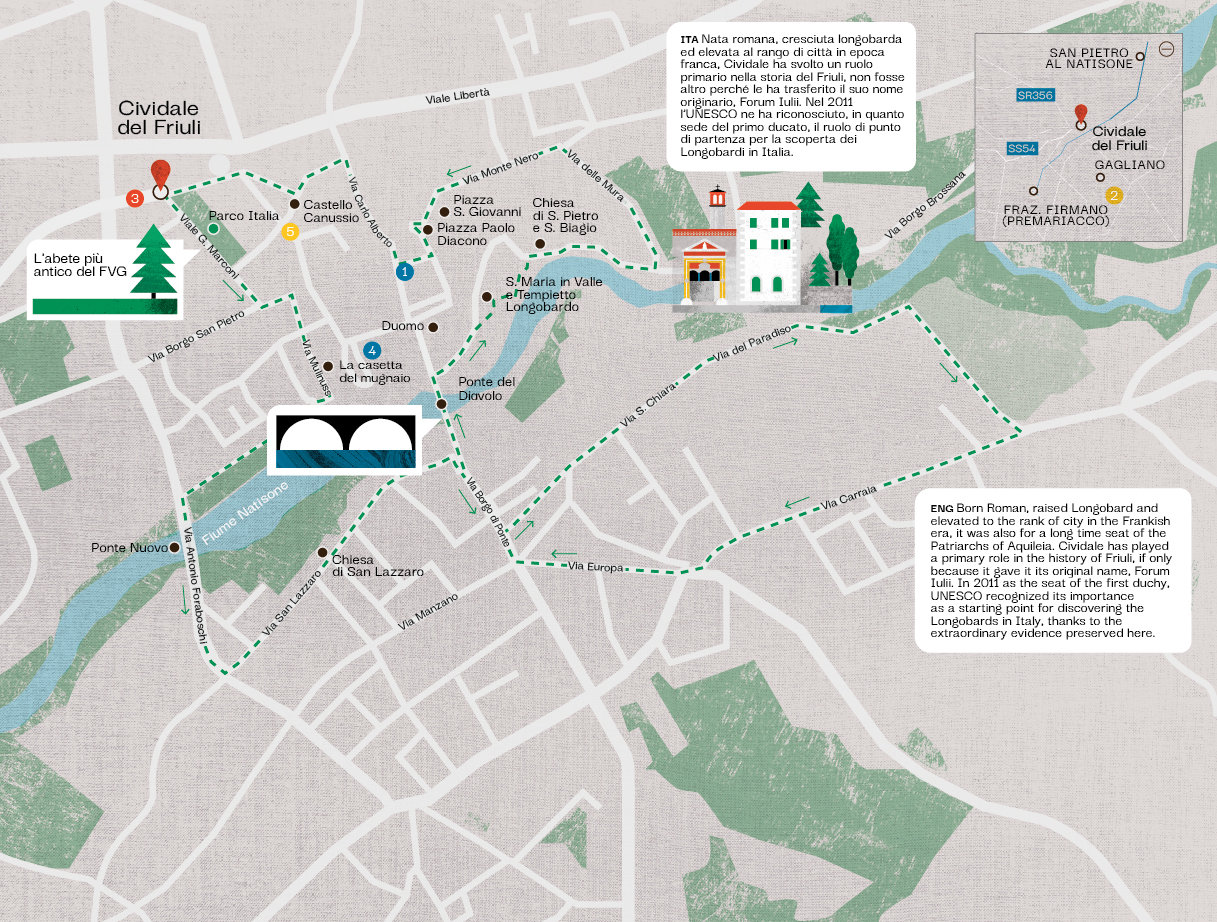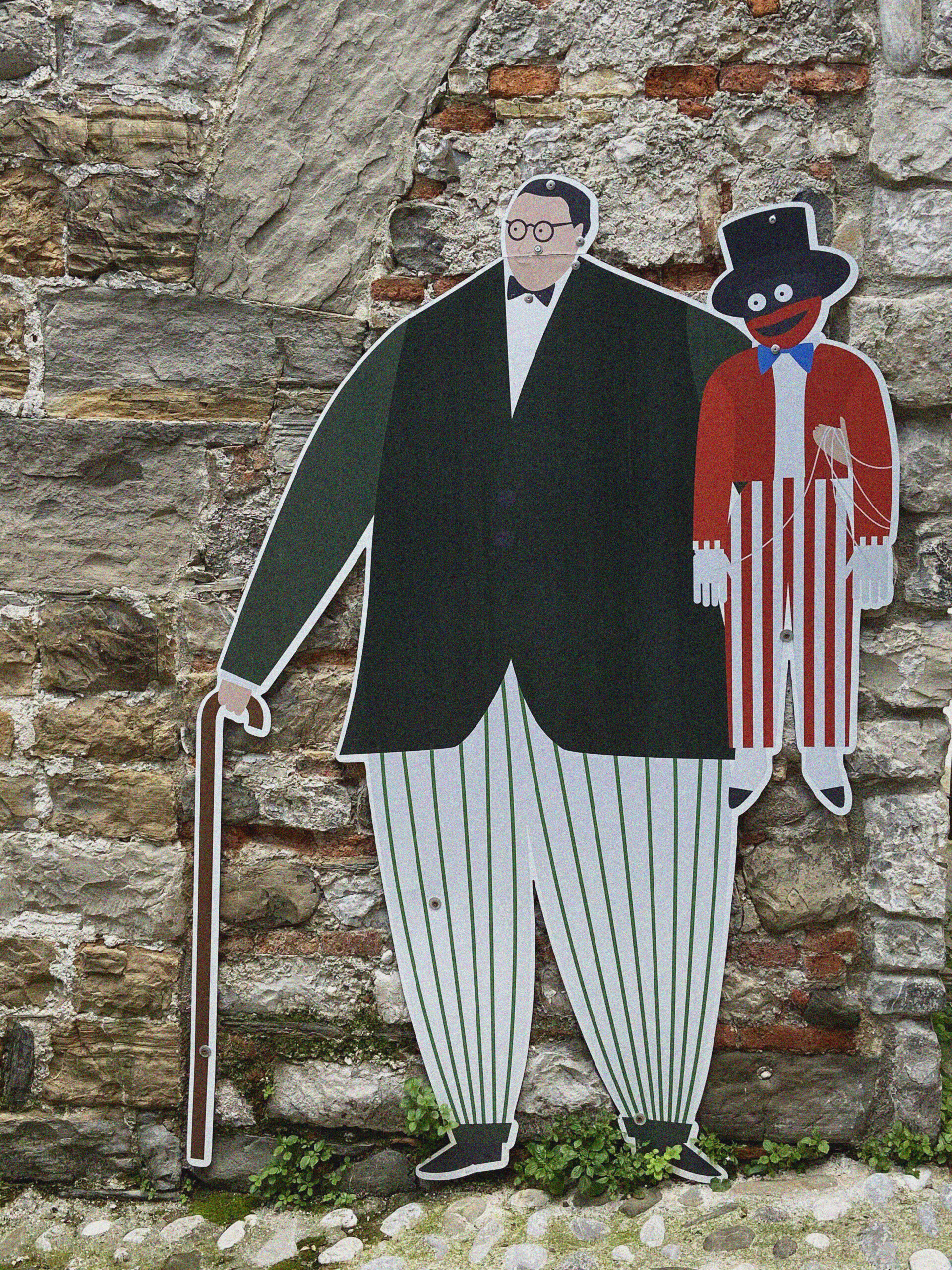On foot between history and legend
I would like to imagine that you arrived in Cividale from Udine by train or with the “littorina” as it is still called by the local people. The starting point for your slow journey in search of the identity of this place is in fact the railway station. Upon your arrival, an unexpected surprise! A modern complex that houses a bank. You didn’t expect to find this futuristic architecture in a UNESCO city, did you? Beginning with Parco Italia, I would like to introduce you to “Arnoldo”, the tallest black pine tree in the region of Friuli Venezia Giulia, a majestic specimen of Pinus Nigra, which is approximately 130 years old and over 25 metres tall. Leaving the park, continue towards Borgo San Pietro, on the left, you will see the Arsenale Veneto, the gateway to the village. Walking straight ahead, you will reach Via dei Mulinuss, (small mills), to indicate the mills that once stood along the water course on your right. Today only a small house remains as a reminder of this activity, restored after the severe earthquake of the year 1976 and now home to the alpine troops. Until the 1960s, a miller worked here; many people in Cividale still remember him. Climb up the steps and walk along the shaded lane that runs along the right bank of the Natisone river, and at the very end, you will find a majestic keep and walls from the Venetian era, which mark the borders of Borgo San Pietro. On the left, you will find Ponte Nuovo (New Bridge), from here a glimpse of the symbol of Cividale, Ponte del Diavolo (Devil’s Bridge). Don’t miss the opportunity for a photo, we will walk across it, but the view from this vantage point is absolutely unique. If you take the first street on the left at the end of the bridge, Via San Lazzaro, you arrive in Borgo di Ponte. Along the road, you will see the façade of a small church dedicated to Saint Lazarus, a small fresco commemorating him on the façade of the house next door, the remains of ancient medieval walls, traces of a moat, a noble palace, and finally, at the end of the street, on the left, the famous Devil’s Bridge. No description of Cividale does not mention the legend of this bridge built in one night by the devil himself! If you are a hiker, however, and want to extend your tour, do not cross the bridge but turn right, pass the Venetian walls and continue left. If it helps you, follow the Alpe Adria Trail signpost, and you can’t go wrong. You will reach Via del Paradiso in a few minutes, the road narrows, and the vegetation thickens.
To complete the route, turn back as far as Devil’s Bridge, which legend has was completed by the Devil in one night in exchange for the soul of the first inhabitant of Cividale who crossed it, but the first creature to step on it was either a dog or a cat. To the right at the end of the bridge, you will be drawn into the unique medieval atmosphere of Via Monastero Maggiore, the heart of Borgo Brossana. Here you will find one of the quintessential masterpieces of the Longobard era: the Tempietto Longobardo. Many surprises are awaiting you in this part of town. You will have already glimpsed a slightly chubby gentleman with a puppet, standing at the entrance of a building. He is Vittorio Podrecca, the father of children’s theatre, inviting passers-by to visit the museum dedicated to him: the CIPS (Podrecca Signorelli International Centre). If you are with children the stop is mandatory, if there are only adults it is equally so. You will be greeted by puppets, and marionettes, competing for your attention. A little further on, in Piazzetta San Pietro e San Biagio, on the façade of the church, there is another character waiting for you: Saint Christopher, the patron saint of travellers and pilgrims who passed through here in large numbers on their journey descending from the north. At the junction with Via delle Mura, turn left. On one side you will see the Venetian walls still visible to some extent, on the other the Natisone Valleys in the distance. To continue the route you have to climb gently and reach Piazza San Giovanni. From here, up until the 1950s, the bus departed for the Natisone Valleys, transporting passengers to Cividale on the two weekly market days. In this square, one could leave the animal that had been purchased and continue shopping and then go back to retrieve it before boarding the bus. The only ticket to be paid was probably a well-deserved drink at the establishment that housed the animal. The market in Cividale was a feast! Women, children, and men came there. The bus sometimes overflowed with people and animals, so much so that it needed a push to get it moving on its way! An arcade passageway, the Volton, leads you to the Piazza delle Donne, officially Piazza Paolo Diacono, once a market square; here on Thursdays and Saturdays, which were market days, the women reigned supreme. And now all you have to do is cross Borgo San Domenico, along Via Carlo Alberto to Via Canussio. Here, halfway down the street, you will find a building with singular, and eclectic architecture. This is the Canussio Craigher Castle, an ancient building, which has been revisited and extended over the centuries, a site that has performed various functions: imagine that it was even a carabinieri police barracks for a certain period! Just a few more steps along Viale Monsignor Liva, Viale della Libertà and you have arrived at the starting point, the railway station; the “littorina”, in its modern version, is ready to go!






